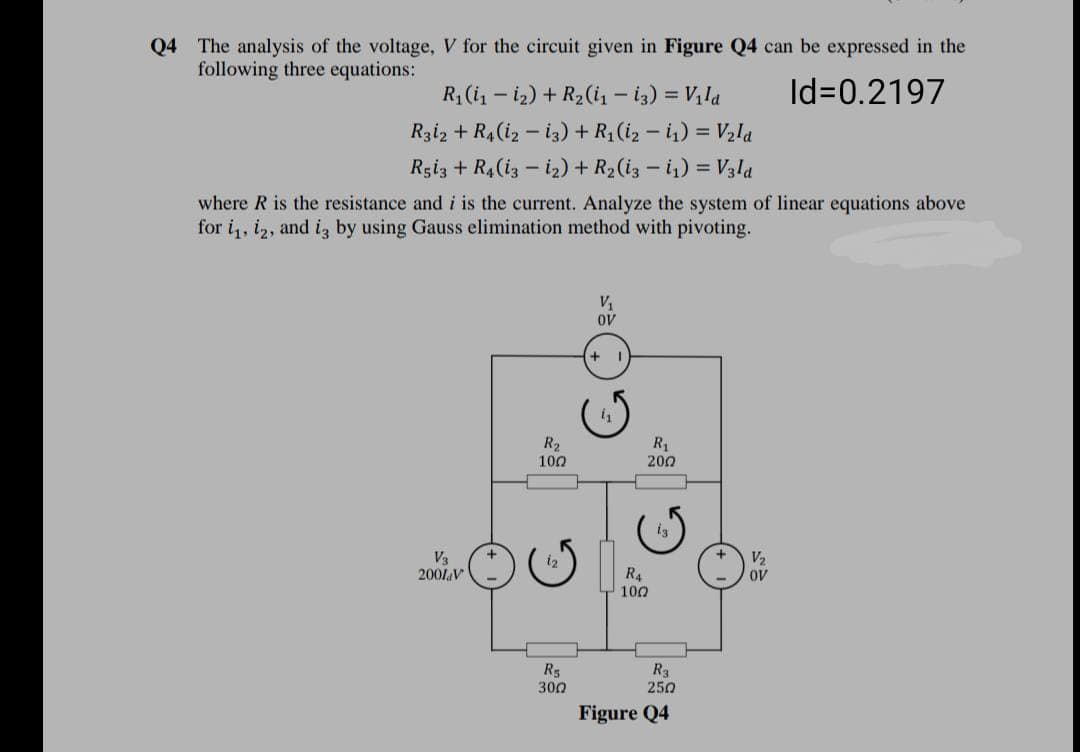The analysis of the voltage, V for the circuit given in Figure Q4 can be expressed in the following three equations: R1 (i - i2) + R2(i, - i3) = Vila Id=0.2197 Rziz + R4(i2 - i3) + R1 (i2 - i) = V½la Rgiz + R4(iz – i2) + R2(iz - i) = V3la where R is the resistance and i is the current. Analyze the system of linear equations above for i,, i2, and i, by using Gauss elimination method with pivoting.
The analysis of the voltage, V for the circuit given in Figure Q4 can be expressed in the following three equations: R1 (i - i2) + R2(i, - i3) = Vila Id=0.2197 Rziz + R4(i2 - i3) + R1 (i2 - i) = V½la Rgiz + R4(iz – i2) + R2(iz - i) = V3la where R is the resistance and i is the current. Analyze the system of linear equations above for i,, i2, and i, by using Gauss elimination method with pivoting.
Introductory Circuit Analysis (13th Edition)
13th Edition
ISBN:9780133923605
Author:Robert L. Boylestad
Publisher:Robert L. Boylestad
Chapter1: Introduction
Section: Chapter Questions
Problem 1P: Visit your local library (at school or home) and describe the extent to which it provides literature...
Related questions
Question
Please answer asap...tq
Numerical Method

Transcribed Image Text:Q4 The analysis of the voltage, V for the circuit given in Figure Q4 can be expressed in the
following three equations:
R1 (i, – iz) + R2(i, – i3) = Vị la
Id=0.2197
Rziz + R4(iz – iz) + R (iz – i) = V2la
Rgiz + R4 (i3 – iz) + R2(i3 – i,) = V3la
where R is the resistance and i is the current. Analyze the system of linear equations above
for i, iz, and iz by using Gauss elimination method with pivoting.
V1
OV
R2
100
R1
200
V3
2001V
i2
V2
R4
100
ov
R5
300
R3
250
Figure Q4
![(b)
A system which is represented by the given equation below, is able to work effectively
even when the time is zero.
f(t) = 7t3 – 0.31t² + lat – cost ld%3D0.2197
However, there will be a time where the system is put on resting mode for several
seconds.
(i)
Find the derivative of f(t).
(ii) By using Newton-Raphson Method, select the approximate resting time in
between the interval [1 2] seconds with the absolute system function tolerance is
less than 0.0005 or until 4th iteration. Choose to = 1 second.](/v2/_next/image?url=https%3A%2F%2Fcontent.bartleby.com%2Fqna-images%2Fquestion%2Fb0e37c83-319b-4460-924f-bb8a889a0d15%2F5fbfb008-d383-4921-83c2-9fa037088e0d%2F4d2t4qr_processed.jpeg&w=3840&q=75)
Transcribed Image Text:(b)
A system which is represented by the given equation below, is able to work effectively
even when the time is zero.
f(t) = 7t3 – 0.31t² + lat – cost ld%3D0.2197
However, there will be a time where the system is put on resting mode for several
seconds.
(i)
Find the derivative of f(t).
(ii) By using Newton-Raphson Method, select the approximate resting time in
between the interval [1 2] seconds with the absolute system function tolerance is
less than 0.0005 or until 4th iteration. Choose to = 1 second.
Expert Solution
This question has been solved!
Explore an expertly crafted, step-by-step solution for a thorough understanding of key concepts.
Step by step
Solved in 5 steps with 9 images

Knowledge Booster
Learn more about
Need a deep-dive on the concept behind this application? Look no further. Learn more about this topic, electrical-engineering and related others by exploring similar questions and additional content below.Recommended textbooks for you

Introductory Circuit Analysis (13th Edition)
Electrical Engineering
ISBN:
9780133923605
Author:
Robert L. Boylestad
Publisher:
PEARSON

Delmar's Standard Textbook Of Electricity
Electrical Engineering
ISBN:
9781337900348
Author:
Stephen L. Herman
Publisher:
Cengage Learning

Programmable Logic Controllers
Electrical Engineering
ISBN:
9780073373843
Author:
Frank D. Petruzella
Publisher:
McGraw-Hill Education

Introductory Circuit Analysis (13th Edition)
Electrical Engineering
ISBN:
9780133923605
Author:
Robert L. Boylestad
Publisher:
PEARSON

Delmar's Standard Textbook Of Electricity
Electrical Engineering
ISBN:
9781337900348
Author:
Stephen L. Herman
Publisher:
Cengage Learning

Programmable Logic Controllers
Electrical Engineering
ISBN:
9780073373843
Author:
Frank D. Petruzella
Publisher:
McGraw-Hill Education

Fundamentals of Electric Circuits
Electrical Engineering
ISBN:
9780078028229
Author:
Charles K Alexander, Matthew Sadiku
Publisher:
McGraw-Hill Education

Electric Circuits. (11th Edition)
Electrical Engineering
ISBN:
9780134746968
Author:
James W. Nilsson, Susan Riedel
Publisher:
PEARSON

Engineering Electromagnetics
Electrical Engineering
ISBN:
9780078028151
Author:
Hayt, William H. (william Hart), Jr, BUCK, John A.
Publisher:
Mcgraw-hill Education,